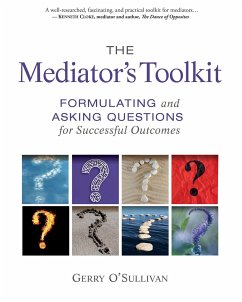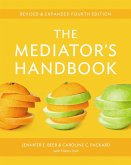- Broschiertes Buch
- Merkliste
- Auf die Merkliste
- Bewerten Bewerten
- Teilen
- Produkt teilen
- Produkterinnerung
- Produkterinnerung
The Mediator's Toolkit offers an array of methods for mediators to develop the skills to formulate and ask strategic questions that shift perspectives and result in successful mediated outcomes in any context.
Andere Kunden interessierten sich auch für
![The Mediator's Handbook The Mediator's Handbook]() Beer, Dr. Jennifer E., PhDThe Mediator's Handbook33,99 €
Beer, Dr. Jennifer E., PhDThe Mediator's Handbook33,99 €![The Art of Focused Conversation, Second Edition The Art of Focused Conversation, Second Edition]() The Art of Focused Conversation, Second Edition26,99 €
The Art of Focused Conversation, Second Edition26,99 €![Kissinger the Negotiator Kissinger the Negotiator]() James K. SebeniusKissinger the Negotiator26,99 €
James K. SebeniusKissinger the Negotiator26,99 €![Transformative Negotiation Transformative Negotiation]() Sarah FedermanTransformative Negotiation29,99 €
Sarah FedermanTransformative Negotiation29,99 €![Getting to Yes Getting to Yes]() Roger FisherGetting to Yes24,99 €
Roger FisherGetting to Yes24,99 €![Radical Collaboration Radical Collaboration]() James W. TammRadical Collaboration20,99 €
James W. TammRadical Collaboration20,99 €![Getting to Yes with Yourself Getting to Yes with Yourself]() William UryGetting to Yes with Yourself20,99 €
William UryGetting to Yes with Yourself20,99 €-
-
-
The Mediator's Toolkit offers an array of methods for mediators to develop the skills to formulate and ask strategic questions that shift perspectives and result in successful mediated outcomes in any context.
Produktdetails
- Produktdetails
- Verlag: New Society Publishers
- Seitenzahl: 256
- Erscheinungstermin: 18. September 2018
- Englisch
- Abmessung: 252mm x 208mm x 20mm
- Gewicht: 590g
- ISBN-13: 9780865718975
- ISBN-10: 0865718970
- Artikelnr.: 50989372
- Herstellerkennzeichnung
- Libri GmbH
- Europaallee 1
- 36244 Bad Hersfeld
- gpsr@libri.de
- Verlag: New Society Publishers
- Seitenzahl: 256
- Erscheinungstermin: 18. September 2018
- Englisch
- Abmessung: 252mm x 208mm x 20mm
- Gewicht: 590g
- ISBN-13: 9780865718975
- ISBN-10: 0865718970
- Artikelnr.: 50989372
- Herstellerkennzeichnung
- Libri GmbH
- Europaallee 1
- 36244 Bad Hersfeld
- gpsr@libri.de
Gerry O'Sullivan is a mediator, trainer, and facilitator with over 30 years of experience in conflict resolution and training. She is an advanced member of the Mediators' Institute of Ireland (MII) and is a member of the US-based Mediators Beyond Borders Consultants Team. She has delivered training internationally with Lawyers Without Borders, in partnership with the Director of Training from CEDR, UK. Gerry delivers accredited Certified Professional Mediation Training in Ireland and has delivered mediation training for the University of Limerick's Masters in Peace and Development program, and she was involved in the development of mediation training in the Law Faculty of Griffith College, Ireland. Gerry is Director of O'Sullivan Solutions and she lives on the southwest coast of Ireland.
Acknowledgments
Glossary
Introduction
Book Content
Terminology
Sequences of Questions
SECTION I: The S Questions Model - Theory
Chapter 1: Introduction and Purpose of the S Questions Model
The S Questions Model
Premise on Which the S Questions Model Has Been Developed
Outline Summary of the Model
The S Questions Model
The Purpose of Mediation Questions
Perspective and Paradigm
Chapter 2: How We Process and Communicate Information
How Information Is Processed
Factors That Contribute to the Information That We Process
The NLP Model of Communication
Our Created Paradigm Becomes Our Reference Point for Interpreting
Information
How We Communicate Information to Others
Distortion, Deletion and Generalization When Communicating to Others
The Surface Structure Language We Use When We Communicate with Others
Using Mediation Questions to Create a Paradigm Shift
Chapter 3: Working with the Brain in Mediation
The Brain
Working with the Avoid-threat Reflex in Mediation
SECTION 2: Practical Application of the S Questions Model
Chapter 4: Methodology to Minimize an Avoid-threat Reflex When Asking
Questions
Methodology
Chapter 5: The S Questions Model Applied to a Mediation Process
Reflective Preparation for Questions
The S Questions Model
S Questions Model Applied to Initial Separate Meeting
S Questions Model Applied to Joint Meeting
SECTION 3: Practical Application of S1, S2 and S3 Questions
Chapter 6: S1: The Subject Matter Dimension of Questions
Chapter 7: S2: The Structure Dimension of Questions
Chapter 8: S3: The Seeking Information Dimension of Questions
SECTION 4: Practical Application of S4 Questions
Chapter 9: Introduction: The Eight Types of S4: Shift Thinking Dimension of
Questions 91
S4: The Shift Thinking Dimension of Questions
Chapter 10: S4: Journey of Inference Questions
S4: The Shift Thinking Dimension of Questions - Journey of Inference
Questions
How Do Journey of Inference Questions Work?
When to Ask Journey of Inference Questions
Methodology
Chapter 11: S4: Neuro-Linguistic Programming Questions
S4: The Shift Thinking Dimension of Questions - Neuro-Linguistic
Programming Questions
How Do Neuro-Linguistic Programming Questions Work?
When to Ask Neuro-Linguistic Programming-based Questions
Methodology
Chapter 12: S4: Distinction and Difference Questions
S4: The Shift Thinking Dimension of Questions - Distinction and
Difference Questions
How Do Distinction and Difference Questions Work?
When to Ask Distinction and Difference Questions
Methodology
Chapter 13: S4: Reflective Connecting Questions
S4: The Shift Thinking Dimension of Questions - Reflective Connecting
Questions
How Do Reflective Connecting Questions Work?
When to Ask Reflective Connecting Questions
Methodology
Chapter 14: S4: Cognitive Elements-based Questions
S4: The Shift Thinking Dimension of Questions - Cognitive
Elements-Based Questions
How Do Cognitive Elements-based Questions Work?
When to Ask Cognitive Elements-based Questions
Methodology
Chapter 15: S4: Other People Questions
S4: The Shift Thinking Dimension of Questions - Other People Questions
How Do Other People Questions Work?
When to Ask Other People Questions
Methodology
Chapter 16: S4: Underlying Interests Questions
S4: The Shift Thinking Dimension of Questions - Underlying Interests
Questions
How Do Underlying Interests Questions Work?
When to Ask Underlying Interests Questions
Methodology
Chapter 17: S4: Future Focus Questions
S4: The Shift Thinking Dimension of Questions - Future Focus Questions
How Do Future Focus Questions Work?
When to Ask Future Focus Questions
Methodology
Endnotes
Index
About the Authors
A Note about the Publisher
Glossary
Introduction
Book Content
Terminology
Sequences of Questions
SECTION I: The S Questions Model - Theory
Chapter 1: Introduction and Purpose of the S Questions Model
The S Questions Model
Premise on Which the S Questions Model Has Been Developed
Outline Summary of the Model
The S Questions Model
The Purpose of Mediation Questions
Perspective and Paradigm
Chapter 2: How We Process and Communicate Information
How Information Is Processed
Factors That Contribute to the Information That We Process
The NLP Model of Communication
Our Created Paradigm Becomes Our Reference Point for Interpreting
Information
How We Communicate Information to Others
Distortion, Deletion and Generalization When Communicating to Others
The Surface Structure Language We Use When We Communicate with Others
Using Mediation Questions to Create a Paradigm Shift
Chapter 3: Working with the Brain in Mediation
The Brain
Working with the Avoid-threat Reflex in Mediation
SECTION 2: Practical Application of the S Questions Model
Chapter 4: Methodology to Minimize an Avoid-threat Reflex When Asking
Questions
Methodology
Chapter 5: The S Questions Model Applied to a Mediation Process
Reflective Preparation for Questions
The S Questions Model
S Questions Model Applied to Initial Separate Meeting
S Questions Model Applied to Joint Meeting
SECTION 3: Practical Application of S1, S2 and S3 Questions
Chapter 6: S1: The Subject Matter Dimension of Questions
Chapter 7: S2: The Structure Dimension of Questions
Chapter 8: S3: The Seeking Information Dimension of Questions
SECTION 4: Practical Application of S4 Questions
Chapter 9: Introduction: The Eight Types of S4: Shift Thinking Dimension of
Questions 91
S4: The Shift Thinking Dimension of Questions
Chapter 10: S4: Journey of Inference Questions
S4: The Shift Thinking Dimension of Questions - Journey of Inference
Questions
How Do Journey of Inference Questions Work?
When to Ask Journey of Inference Questions
Methodology
Chapter 11: S4: Neuro-Linguistic Programming Questions
S4: The Shift Thinking Dimension of Questions - Neuro-Linguistic
Programming Questions
How Do Neuro-Linguistic Programming Questions Work?
When to Ask Neuro-Linguistic Programming-based Questions
Methodology
Chapter 12: S4: Distinction and Difference Questions
S4: The Shift Thinking Dimension of Questions - Distinction and
Difference Questions
How Do Distinction and Difference Questions Work?
When to Ask Distinction and Difference Questions
Methodology
Chapter 13: S4: Reflective Connecting Questions
S4: The Shift Thinking Dimension of Questions - Reflective Connecting
Questions
How Do Reflective Connecting Questions Work?
When to Ask Reflective Connecting Questions
Methodology
Chapter 14: S4: Cognitive Elements-based Questions
S4: The Shift Thinking Dimension of Questions - Cognitive
Elements-Based Questions
How Do Cognitive Elements-based Questions Work?
When to Ask Cognitive Elements-based Questions
Methodology
Chapter 15: S4: Other People Questions
S4: The Shift Thinking Dimension of Questions - Other People Questions
How Do Other People Questions Work?
When to Ask Other People Questions
Methodology
Chapter 16: S4: Underlying Interests Questions
S4: The Shift Thinking Dimension of Questions - Underlying Interests
Questions
How Do Underlying Interests Questions Work?
When to Ask Underlying Interests Questions
Methodology
Chapter 17: S4: Future Focus Questions
S4: The Shift Thinking Dimension of Questions - Future Focus Questions
How Do Future Focus Questions Work?
When to Ask Future Focus Questions
Methodology
Endnotes
Index
About the Authors
A Note about the Publisher
Acknowledgments
Glossary
Introduction
Book Content
Terminology
Sequences of Questions
SECTION I: The S Questions Model - Theory
Chapter 1: Introduction and Purpose of the S Questions Model
The S Questions Model
Premise on Which the S Questions Model Has Been Developed
Outline Summary of the Model
The S Questions Model
The Purpose of Mediation Questions
Perspective and Paradigm
Chapter 2: How We Process and Communicate Information
How Information Is Processed
Factors That Contribute to the Information That We Process
The NLP Model of Communication
Our Created Paradigm Becomes Our Reference Point for Interpreting
Information
How We Communicate Information to Others
Distortion, Deletion and Generalization When Communicating to Others
The Surface Structure Language We Use When We Communicate with Others
Using Mediation Questions to Create a Paradigm Shift
Chapter 3: Working with the Brain in Mediation
The Brain
Working with the Avoid-threat Reflex in Mediation
SECTION 2: Practical Application of the S Questions Model
Chapter 4: Methodology to Minimize an Avoid-threat Reflex When Asking
Questions
Methodology
Chapter 5: The S Questions Model Applied to a Mediation Process
Reflective Preparation for Questions
The S Questions Model
S Questions Model Applied to Initial Separate Meeting
S Questions Model Applied to Joint Meeting
SECTION 3: Practical Application of S1, S2 and S3 Questions
Chapter 6: S1: The Subject Matter Dimension of Questions
Chapter 7: S2: The Structure Dimension of Questions
Chapter 8: S3: The Seeking Information Dimension of Questions
SECTION 4: Practical Application of S4 Questions
Chapter 9: Introduction: The Eight Types of S4: Shift Thinking Dimension of
Questions 91
S4: The Shift Thinking Dimension of Questions
Chapter 10: S4: Journey of Inference Questions
S4: The Shift Thinking Dimension of Questions - Journey of Inference
Questions
How Do Journey of Inference Questions Work?
When to Ask Journey of Inference Questions
Methodology
Chapter 11: S4: Neuro-Linguistic Programming Questions
S4: The Shift Thinking Dimension of Questions - Neuro-Linguistic
Programming Questions
How Do Neuro-Linguistic Programming Questions Work?
When to Ask Neuro-Linguistic Programming-based Questions
Methodology
Chapter 12: S4: Distinction and Difference Questions
S4: The Shift Thinking Dimension of Questions - Distinction and
Difference Questions
How Do Distinction and Difference Questions Work?
When to Ask Distinction and Difference Questions
Methodology
Chapter 13: S4: Reflective Connecting Questions
S4: The Shift Thinking Dimension of Questions - Reflective Connecting
Questions
How Do Reflective Connecting Questions Work?
When to Ask Reflective Connecting Questions
Methodology
Chapter 14: S4: Cognitive Elements-based Questions
S4: The Shift Thinking Dimension of Questions - Cognitive
Elements-Based Questions
How Do Cognitive Elements-based Questions Work?
When to Ask Cognitive Elements-based Questions
Methodology
Chapter 15: S4: Other People Questions
S4: The Shift Thinking Dimension of Questions - Other People Questions
How Do Other People Questions Work?
When to Ask Other People Questions
Methodology
Chapter 16: S4: Underlying Interests Questions
S4: The Shift Thinking Dimension of Questions - Underlying Interests
Questions
How Do Underlying Interests Questions Work?
When to Ask Underlying Interests Questions
Methodology
Chapter 17: S4: Future Focus Questions
S4: The Shift Thinking Dimension of Questions - Future Focus Questions
How Do Future Focus Questions Work?
When to Ask Future Focus Questions
Methodology
Endnotes
Index
About the Authors
A Note about the Publisher
Glossary
Introduction
Book Content
Terminology
Sequences of Questions
SECTION I: The S Questions Model - Theory
Chapter 1: Introduction and Purpose of the S Questions Model
The S Questions Model
Premise on Which the S Questions Model Has Been Developed
Outline Summary of the Model
The S Questions Model
The Purpose of Mediation Questions
Perspective and Paradigm
Chapter 2: How We Process and Communicate Information
How Information Is Processed
Factors That Contribute to the Information That We Process
The NLP Model of Communication
Our Created Paradigm Becomes Our Reference Point for Interpreting
Information
How We Communicate Information to Others
Distortion, Deletion and Generalization When Communicating to Others
The Surface Structure Language We Use When We Communicate with Others
Using Mediation Questions to Create a Paradigm Shift
Chapter 3: Working with the Brain in Mediation
The Brain
Working with the Avoid-threat Reflex in Mediation
SECTION 2: Practical Application of the S Questions Model
Chapter 4: Methodology to Minimize an Avoid-threat Reflex When Asking
Questions
Methodology
Chapter 5: The S Questions Model Applied to a Mediation Process
Reflective Preparation for Questions
The S Questions Model
S Questions Model Applied to Initial Separate Meeting
S Questions Model Applied to Joint Meeting
SECTION 3: Practical Application of S1, S2 and S3 Questions
Chapter 6: S1: The Subject Matter Dimension of Questions
Chapter 7: S2: The Structure Dimension of Questions
Chapter 8: S3: The Seeking Information Dimension of Questions
SECTION 4: Practical Application of S4 Questions
Chapter 9: Introduction: The Eight Types of S4: Shift Thinking Dimension of
Questions 91
S4: The Shift Thinking Dimension of Questions
Chapter 10: S4: Journey of Inference Questions
S4: The Shift Thinking Dimension of Questions - Journey of Inference
Questions
How Do Journey of Inference Questions Work?
When to Ask Journey of Inference Questions
Methodology
Chapter 11: S4: Neuro-Linguistic Programming Questions
S4: The Shift Thinking Dimension of Questions - Neuro-Linguistic
Programming Questions
How Do Neuro-Linguistic Programming Questions Work?
When to Ask Neuro-Linguistic Programming-based Questions
Methodology
Chapter 12: S4: Distinction and Difference Questions
S4: The Shift Thinking Dimension of Questions - Distinction and
Difference Questions
How Do Distinction and Difference Questions Work?
When to Ask Distinction and Difference Questions
Methodology
Chapter 13: S4: Reflective Connecting Questions
S4: The Shift Thinking Dimension of Questions - Reflective Connecting
Questions
How Do Reflective Connecting Questions Work?
When to Ask Reflective Connecting Questions
Methodology
Chapter 14: S4: Cognitive Elements-based Questions
S4: The Shift Thinking Dimension of Questions - Cognitive
Elements-Based Questions
How Do Cognitive Elements-based Questions Work?
When to Ask Cognitive Elements-based Questions
Methodology
Chapter 15: S4: Other People Questions
S4: The Shift Thinking Dimension of Questions - Other People Questions
How Do Other People Questions Work?
When to Ask Other People Questions
Methodology
Chapter 16: S4: Underlying Interests Questions
S4: The Shift Thinking Dimension of Questions - Underlying Interests
Questions
How Do Underlying Interests Questions Work?
When to Ask Underlying Interests Questions
Methodology
Chapter 17: S4: Future Focus Questions
S4: The Shift Thinking Dimension of Questions - Future Focus Questions
How Do Future Focus Questions Work?
When to Ask Future Focus Questions
Methodology
Endnotes
Index
About the Authors
A Note about the Publisher








